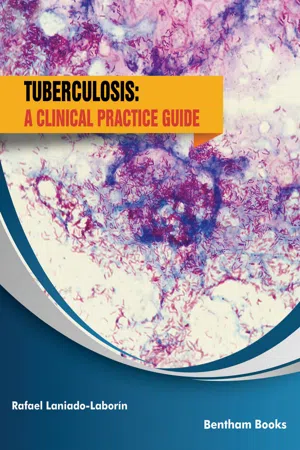Treatment of Drug-Resistant Tuberculosis
Rafael Laniado-Laborín Abstract
The presence of drug resistance should always be suspected when there are risk factors for it and must be confirmed by bacteriological or molecular tests for standardized drug sensitivity. Any regimen for drug-resistant TB is more likely to be effective if its composition is based on information from reliable drug susceptibility testing.
The presence of drug-resistant tuberculosis should be suspected in patients who are failing treatment, in patients with TB relapse, in subjects coming from regions with a high prevalence of MDR-TB, and in contacts of known cases of MDR-TB. Although there are multiple reasons why treatment may fail, the most frequent is the lack of adherence to the regimen.
The most common causes of relapse include lack of adherence to treatment with the development of acquired drug resistance, treatment with an inadequate therapeutic regimen, malabsorption of drugs, and exogenous reinfection with a different strain of M. tuberculosis.
In patients with confirmed rifampicin-susceptible and isoniazid-resistant tuberculosis, treatment with rifampicin, ethambutol, pyrazinamide, and levofloxacin is recommended for a duration of 6 months.
One general WHO recommendation is that all patients with rifampin-resistant TB (even those with monoresistance to rifampin) should be treated with an MDR-TB drug regimen. There are three options for the treatment of RR/MDR/XDR TB. Two are recommendations for programmatic management (the short and longer regimens) and one for operational research (the BPaL regimen).
Keywords: BPaL, Drug-resistant tuberculosis, Longer regimen, Short-course regimen, Treatment.
INTRODUCTION
The presence of drug resistance should always be suspected when there are risk factors for it and must be confirmed by bacteriological or molecular tests for standardized drug sensitivity. Because the treatment of a drug-resistant case will depend heavily on the results of drug susceptibility tests, a maximum effort should be made to isolate M. tuberculosis [1].
The presence of drug-resistant tuberculosis should be suspected in patients who are failing treatment (e.g., the persistence of viable germs in cultures after 4 months of strictly supervised treatment, or presenting positive cultures again after having converted their cultures to negative during treatment), patients with TB relapse, in subjects migrating from regions with a high prevalence of MDR-TB, and in contacts of known cases of MDR-TB. Clinical suspicion of MDR-TB will allow earlier diagnosis and initiation of the treatment (with a better prognosis for the case) and will reduce the transmission of resistant strains in the community.
In fact, the lack of improvement in the symptoms and the persistence of positive microscopy should make the clinician suspect the possibility of drug-resistant TB, and order (if it has not been done yet) phenotypic or genotypic drug susceptibility testing (DST). There are multiple reasons why the treatment may fail, the most frequent being the lack of adherence to the regimen, the acquisition of resistance during the treatment (usually due to lack of adherence or an inadequate regimen), or intestinal malabsorption.
Faced with a patient who is failing, the clinician must determine if cultures and DST were carried out and if drug resistance was present before the initial treatment. Treatment should be stopped, and a new sputum sample should be obtained for rapid molecular tests (Xpert, LPAs), culture and DST that will confirm if there is resistance to drugs, or if it already existed before the initiation of therapy if it now has acquired resistance to other drugs in the regimen [1].
When a patient presents a bacteriological relapse (history of been successfully treated and discharged as cured with negative cultures at the end of the treatment) and presents again with clinical evidence of disease and positive cultures for M. tuberculosis, the possibility of drug-resistant TB is highly probable since the history of previous treatment is one of the most important risk factors for this complication. This is especially frequent in patients who have been treated with unsupervised regimens. Patients treated with directly observed therapy (DOT) have a much lower risk of developing drug-resistance during the treatment. The most common causes of relapse include lack of adherence to treatment with the development of acquired resistance, treatment with an inadequate therapeutic regimen, malabsorption of drugs, and exogenous reinfection with a different strain of M. tuberculosis. An exception is patients with an initial pan-susceptible strain treated under DOT with first-line drugs; there is a high probability that the relapse, in this case, is due to the same pan-susceptible strain (from reactivation of latent bacilli that were not killed during the treatment). Under these conditions, it is recommended to start the primary regimen again while the DST report is available. If, on the contrary, the treatment was not supervised or was irregular, it is recommended to start with an expanded regimen while the DST are being reported, especially if the patient is immunocompromised, has a central nervous system condition or is severely ill. By expanded regimen is meant adding 2 to 3 new drugs (that the patient has never received) to the standard 4-drug regimen [1].
TREATMENT OF DRUG-RESISTANT TUBERCULOSIS
Mono-resitance Resistance to Isoniazid
In its 2019 consolidated guidelines on drug-resistant tuberculosis treatment [2], the WHO published the following recommendations for the treatment of isoniazid-resistant tuberculosis:
- In patients with confirmed rifampicin-susceptible and isoniazid-resistant tuberculosis, treatment with rifampicin, ethambutol, pyrazinamide, and levofloxacin is recommended for a duration of 6 months.
- In patients with confirmed rifampicin-susceptible and isoniazid-resistant tuberculosis, it is not recommended to add streptomycin or other injectable agents to the treatment regimen.
Evidence shows that there is no statistically significant difference in the treatment outcomes of patients receiving six months of the four-drug regimen and those receiving more than six months of the same regimen. This statement only applies to treatment with a daily regimen for six months. Levofloxacin is recommended over moxifloxacin due to its lower toxicity and cost. The six-month regimen is also recommended for persons living with HIV.
In patient...
